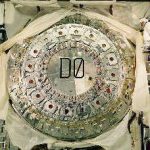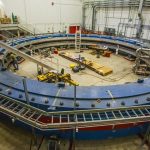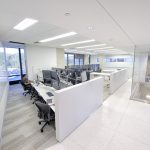Tours are given after each lecture starting at about 11 a.m. and lasting for about 40 minutes. Scientific and technical staff of Fermilab are the tour guides.
Fermilab has a large variety of interesting sites. Important scientific discoveries have been made in many to these sites. The following is a list of sites and a brief description of them:
Wilson HallWilson Hall is the building in which the Fermilab Saturday Morning Physics lectures are given. It was named in honor of the first director of Fermilab, Robert R. Wilson. Wilson was an artist and created several sculptures that are now part of the Fermilab landscape. The tour of Wilson Hall focus mostly on the 15th floor, from which the view is great and where different small-scale models of the site and the accelerator are located. |
|
AcceleratorsFermilab had one of the most energetic chain of accelerators in the world. Historically, the Tevatron accelerated protons and their antimatter counterpart antiprotons to 1 trillion-volt energies. The tour will show the 1st stage accelerator chain from which everything started (picture). The location of Fermilab’s cancer therapy facility will be shown, as well as the Main Control Room, from which staff control all of the particle beams on site. For other interesting pictures of the accelerators at Fermilab, click here. |
|
 |
DØPronounced as dee-zero, this is one of the two large collider particle detectors (or “cameras”) at the Tevatron. The discovery of the fundamental particle, the “top quark,” was achieved at this site and at its counterpart detector CDF. CDF also surrounded one of the points in the Tevatron ring where protons and antiprotons collided. Having two detectors allowed scientists to check their results against each other. To see more diagrams of DØ, click here. DØ exhibit web-site. |
 |
g-2This accelerator is pronounced as gee minus two. The muon is the “big brother” particle to the familiar electron and was discovered in cosmic rays many decades ago. Measurements of the fundamental characteristics of the muon, such as its spin, can be compared to the Standard Model of Particle Physics. Scientists hope to find discrepancies with this model, which will point the way to even more of a basic understanding of the makeup of the universe. |
 |
NeutrinoNeutrinos are the subject of most of the particle physics that is happening at Fermilab. This tour takes visitors to a couple of the facilities on site where scientists and engineers study these elusive particles, starting with the Remote Operations Center (pictured here). |
GCC: Grid Computing CenterThe Grid Computing Center holds more than 10,000 top-of-the-line computers. These computers are used to solve complicated scientific problems. Having a large number of computers allows for faster computation using the technique of parallel processing. Scientists from all over the world use this so-called computer farm. More photos are available here. |
|
Technical Division: Magnet and SRF FacilitiesThe Magnet Facility is part of a complex of buildings where the designing, building, and testing of high-field magnets takes place. This facility built the superconducting quadrupole magnets that focus the beam in the LHC collider in Switzerland. Studies of new superconducting technology, in particular, superconducting radio frequency cavities, take place at this facility. |
|
FASTThe Fermilab Accelerator Science and Technology (FAST) currently under construction at Fermilab will soon enable a broad range of beam-based experiments to study fundamental limitations to beam intensity and to develop transformative approaches to particle-beam generation, acceleration, and manipulation. FAST incorporates a superconducting radio frequency LINAC coupled to a photoinjector and a small-circumference storage ring capable of storing electrons or protons. FAST will establish a unique resource for R&D toward Energy Frontier facilities and serve as a test bed for SRF accelerators and high-brightness beam applications quark. |
